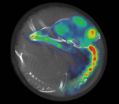(Press-News.org) Adding digital breast tomosynthesis to 2D mammography screening results in a 40% reduction in patient recall rates compared to routine screening mammography alone, a new study shows.
The study, conducted at Yale University School of Medicine in New Haven, CT, of 7,578 screening mammograms, found that the recall rate was 6.6% for digital breast tomosynthesis plus 2D screening mammography. It was 11.1% for 2D screening mammography alone, said Melissa Durand, MD, one of the authors of the study.
Similar recall rates were seen in both groups for masses, but the recall rate was significantly lower with digital breast tomosynthesis and 2D mammography compared to 2D mammography alone for asymmetries and calcifications, said Dr. Durand. The recall rate was 2.8% for asymmetries when both techniques were used compared to 7.1% for routine screening mammography, she said. "Tomosynthesis, which is 3D mammography, allows us to look at the breast in 1 mm slices. In routine mammography, breast tissue is compressed and overlying tissue can look like a suspicious finding. Tomosynthesis resolves this by looking slice by slice," said Liane Philpotts, MD, a study author.
The radiation dose for the combined examination is below the Food and Drug Administration limit for mammography and below the dose of film mammography, noted Dr. Durand. "For now we are doing both examinations, but it may not be long before we will be able to do just the tomosynthesis exam. Researchers are working on ways to get a 2D image out of the 3D data, and when that happens, there may be no need for the 2D examination," Dr. Philpotts said.
"Recalls from screening mammography incite considerable anxiety in women. With digital breast tomosynthesis, we are seeing a dramatic reduction in our recall rates which helps lessen our patients' anxiety. Fewer recalls means fewer additional breast imaging views, which is cost saving and may also reduce overall annual radiation dose," said Dr. Durand.
###
The study is being presented May 3 at the American Roentgen Ray Society Annual Meeting in Vancouver, Canada.
About ARRS
The American Roentgen Ray Society (ARRS) was founded in 1900 and is the oldest radiology society in the United States. Its monthly journal, the American Journal of Roentgenology, began publication in 1906. Radiologists from all over the world attend the ARRS Annual Meeting to take part in instructional courses, scientific paper presentations and scientific and commercial exhibits related to the field of radiology. The Society is named after the first Nobel Laureate in Physics, Wilhelm Röentgen, who discovered the X-ray in 1895.
Digital breast tomosynthesis cuts recall rates by 40 percent
2012-05-04
ELSE PRESS RELEASES FROM THIS DATE:
Olin Business School Student Puts Love of Running to Work for Social Causes
2012-05-04
Members of the Washington University in St. Louis cross country team are ready to run a race in the global marketplace with a goal to fight world hunger and water needs. Janji - the name means promise in Malay - is a socially conscious business that is launching a line of running apparel this month and will be available in more than 60 specialty running stores this summer.
"This public release is something we've been building towards for two years," says Mike Burnstein an avid runner and one of the founders of Janji. Burnstein will graduate this month with ...
'No family history' not a good reason for women 40-49 to stop yearly screening mammograms
2012-05-04
More than half the women aged 40-49 diagnosed with breast cancer on screening mammography report no family history, a new study shows.
The study, conducted at Elizabeth Wende Breast Care, LLC in Rochester, NY of all breast cancers diagnosed between 2000 and 2010, found that 228 out of 373 cancers (61%) were found in women, aged 40-49 with no family history of breast cancer. Seventeen of the 228 patients did have a prior personal history of breast cancer or abnormal cells at a prior biopsy, and were not included in this analysis.
Out of 211 women that remained for ...
Extra gene drove instant leap in human brain evolution
2012-05-04
A partial, duplicate copy of a gene appears to be responsible for the critical features of the human brain that distinguish us from our closest primate kin. The momentous gene duplication event occurred about two or three million years ago, at a critical transition in the evolution of the human lineage, according to a pair of studies published early online in the journal Cell, a Cell Press publication, on May 3rd.
The studies are the first to explore the evolutionary history and function of any uniquely human gene duplicate. These "extra" genes are of special interest ...
Trummell Valdera Looks to Moneyball for HR Analysis
2012-05-04
Oscar-nominated film Moneyball has inspired a data revolution of sorts within the field of human resources. Like Brad Pitt's character in the movie, numerous HR professionals are embracing the value of data and dedicating a great deal of time to analysis in an effort to determine the best HR moves for their organizations. Trummell Valdera, an HR expert who has led many a company to success in its HR operations, has adopted a similar approach. In fact, Trummell Valdera is urging other HR professionals to consider the immense value that such data can provide.
In Moneyball, ...
Waking embryos before they are born
2012-05-04
Under some conditions, the brains of embryonic chicks appear to be awake well before those chicks are ready to hatch out of their eggs. That's according to an imaging study published online on May 3 in Current Biology, a Cell Press publication, in which researchers woke chick embryos inside their eggs by playing loud, meaningful sounds to them. Playing meaningless sounds to the embryos wasn't enough to rouse their brains.
The findings may have implications not only for developing chicks and other animals, but also for prematurely born infants, the researchers say. Pediatricians ...
Exceptional Midcentury, Fine Silver and Rare Art Make Clarke Auction on Monday, May 7th in Larchmont, NY a Collector's Dream Night Out
2012-05-04
Picking has been great this month for the Clarke appraisal team. They have managed once again to put together what -- in the humble opinion of Irish owner and founder, Ronan Clarke - is one of the most diverse and exciting auction offerings in the New York area this month.
While Sotheby's, Doyle's, Christy's, etc. all have great art sales this month, Clarke not only has great art but also a diverse and eclectic mix of midcentury modern, silver, porcelain, rugs, continental furniture and collectibles.
As always, Clarke has its usual gathering of furniture and even ...
Simple assault and ground level fall do not require cervical spine CT
2012-05-04
Cervical spine CT examinations are unnecessary for emergency department (ED) patients who are a victim of "simple assault" or who have a "ground-level fall", unless the patient has a condition that predisposes the patient to spine fracture, a new study finds.
The study, conducted at Grady Memorial Hospital by researchers from the Department of Radiology and Imaging Sciences of the Emory University School of Medicine in Atlanta, found that out of 218 exams for simple assault, there were none that were positive, said Andrew Nicholson, MD, lead author of the study. In the ...
Surgical excision unnecessary in some patients with benign papillomas
2012-05-04
Imaging surveillance is an acceptable alternative to surgical excision in patients with benign papilloma, diagnosed at breast core biopsy without cell abnormalities, a new study shows.
The study, conducted at the Breast Health Center of California Pacific Medical Center in San Francisco, included 119 papillomas diagnosed at core biopsy without abnormal cells. Imaging follow-up of a minimum of two years without surgical excision was performed on 66 lesions; no cancer was found in this group, said Jessica Leung, MD, FACR, lead author of the study. Surgical excision was ...
Study finds 'overmanagement' of benign breast disease
2012-05-04
Contrary to current guidelines, women with benign breast biopsies do not need follow-up at six months; they may not need close surveillance at all, a new study shows.
The study, conducted at Moffitt Cancer Center in Tampa, FL, followed 388 patients for six, 12 and 24 months. No cancer was found in these patients at six and 12 months, said Shannon Reed, MD, one of the authors of the study. "Of the 197 follow-up examinations performed at 24 months, two women were positive for cancer in a different area than had been previously biopsied," said Dr. Reed. An annual ...
Increasing speed of Greenland glaciers gives new insight for rising sea level
2012-05-04
Changes in the speed that ice travels in more than 200 outlet glaciers indicates that Greenland's contribution to rising sea level in the 21st century might be significantly less than the upper limits some scientists thought possible, a new study shows.
"So far, on average we're seeing about a 30 percent speedup in 10 years," said Twila Moon, a University of Washington doctoral student in Earth and space sciences and lead author of a paper documenting the observations published May 4 in Science.
The faster the glaciers move, the more ice and meltwater they release ...


